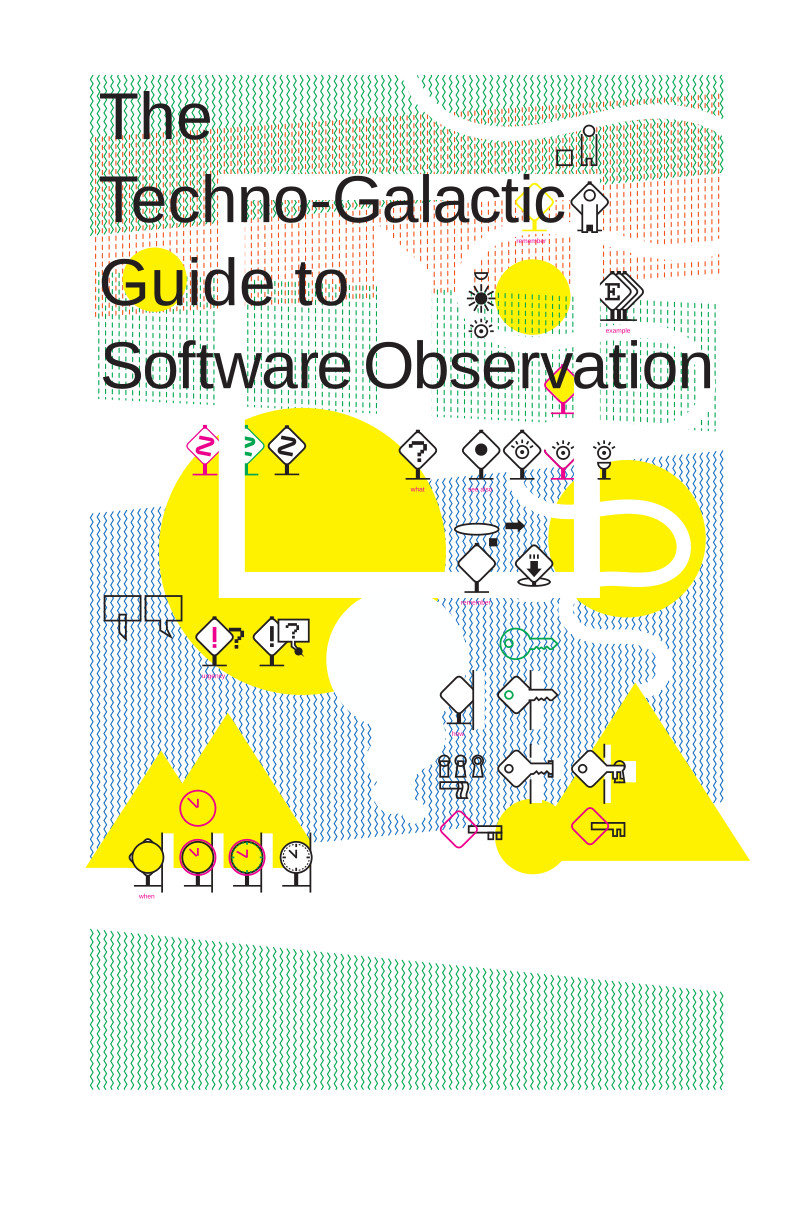The Techno-Galactic Guide to Software Observation (2018)
Filed under book | Tags: · agility, art, code, compilation, design, free software, interface, productivity, software, software studies, time, touch

“This techno-galactic software survival guide was collectively produced as an outcome of the Techno-Galactic Software Observatory (Brussels, 2017). This guide proposes several ways to achieve critical distance from the seemingly endless software systems that surround us. It offers practical and fantastical tools for the tactical (mis)use of software, empowering/enabling users to resist embedded paradigms and assumptions. It is a collection of methods for approaching software, experiencing its myths and realities, its risks and benefits.”
With contributions from Manetta Berends, Željko Blaće, Larisa Blazic, Freyja van den Boom, Anna Carvalho, Loup Cellard, Joana Chicau, Cristina Cochior, Pieter Heremans, Joak aka Joseph Knierzinger, Jogi Hofmüller, Becky Kazansky, Anne Laforet, Ricardo Lafuente, Michaela Lakova, Hans Lammerant, Silvio Lorusso, Mia Melvaer, An Mertens, Lidia Pereira, Donatella Portoghese, Luis Rodil-Fernandez, Natacha Roussel, Andrea di Serego Alighieri, Lonneke van der Velden, Ruben van de Ven, Kym Ward, Wendy Van Wynsberghe, and Peter Westenberg.
Compiled by Carlin Wing, Martino Morandi, Peggy Pierrot, Anita Burato, Christoph Haag, Michael Murtaugh, Femke Snelting, and Seda Gürses
Publisher Constant, Brussels, 2018
Free Art License 1.3
ISBN 9789081145961
244 pages
Publisher
Project folder
Event
PDF, PDF (44 MB)
HTML (different version)
Git
Annet Dekker: Collecting and Conserving Net Art: Moving beyond Conventional Methods (2018)
Filed under book | Tags: · archive, archiving, art documentation, conservation, document, internet art, net art, networks, preservation, software, software art, web

“Collecting and Conserving Net Art explores the qualities and characteristics of net art and its influence on conservation practices. By addressing and answering some of the challenges facing net art and providing an exploration of its intersection with conservation, the book casts a new light on net art, conservation, curating and museum studies.
Viewing net art as a process rather than as a fixed object, the book considers how this is influenced by and executed through other systems and users. Arguing that these processes and networks are imbued with ambiguity, the book suggests that this is strategically used to create suspense, obfuscate existing systems and disrupt power structures. The rapid obsolescence of hardware and software, the existence of many net artworks within restricted platforms and the fact that artworks often act as assemblages that change or mutate, make net art a challenging case for conservation. Taking the performative and interpretive roles conservators play into account, the book demonstrates how practitioners can make more informed decisions when responding to, critically analyzing or working with net art, particularly software-based processes.
Collecting and Conserving Net Art is intended for researchers, academics and postgraduate students, especially those engaged in the study of museum studies, conservation and heritage studies, curatorial studies, digital art and art history. The book should also be interesting to professionals who are involved in the conservation and curation of digital arts, performance, media and software.”
Publisher Routledge, 2018
ISBN 9780815382416, 0815382413
x+192 pages
Computational Culture, 6: Computing the Corporeal / Geographies of Software (2017)
Filed under journal | Tags: · body, computation, computing, dance, geography, movement, movement computing, software, software studies
This issue of Computational Culture consists of two thematic sections. The section “Computing the Corporeal” is concerned with the critique of “the way in which machine computers affect movement-based creativity, and movement-based thinking.” The section “Geographies of Software” presents “geographical approaches to software studies.”
With thematic texts by John Stell, Stamatia Portanova, Scott delaHunta, Anton Koch (section 1), Will Payne, Warren Sack, and Pip Thornton (section 2), editorial introductions, and review section.
Section “Computing the Corporeal” edited by Nicolas Salazar Sutil and Scott delaHunta
Section “Geographies of Software” edited by Nick Lally and Ryan Burns
Published in November 2017
Open Access
ISSN 2047-2390

